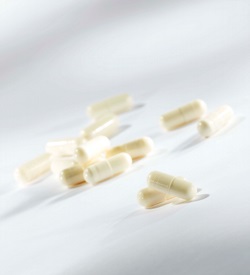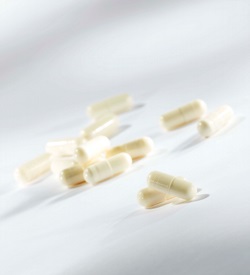Providing Quality & Trust
Detailed Description
Estriol Capsule
Estriol may be prescribed for
- Hormone Replacement
One of the dosage forms available for Estriol is Capsule. Wedgewood Pharmacy compounds more than 2,000 formulations in capsule form. The potency of each compounded capsule is verified through weight and yield checks before it is dispensed.
5 strengths of Estriol Capsule are available, ranging from 0.25 mg/cap to 2.85 mg/cap.
Uses / Indications
The FDA (US) has approved estriol for the control of estrogen-responsive urinary incontinence (urethral sphincter mechanism incompetence; USMI) in ovariohysterectomized female dogs. At present, estriol is the only estrogen approved in the US for this use.
No clinical studies were found that compared efficacy or adverse effects of estriol with other estrogens (eg, diethylstilbestrol) or alpha-adrenergic drugs (eg, phenylpropanolamine) in female dogs with USMI. Some have proposed that using an estrogen with an alpha-adrenergic may be more effective and allow dosage reductions for both drugs; however, a 2006 study compared estriol alone to estriol in combination with phenylpropanolamine in female dogs and showed no difference in urethral resistance.1
Pharmacology / Actions
Estriol is a short acting estrogenic drug. By binding to estrogen receptors found in the female canine lower urinary tract, estriol can, in ovariohysterectomized dogs, improve urinary continence. This effect is thought to occur through enhanced urethral sphincter tone via increased sensitivity of urethral smooth muscle receptors to norepinephrine and thus, increased smooth muscle contractility. In comparison to estradiol-17 beta or diethylstilbestrol, estradiol binds to estrogen receptors for a much shorter period, yet can still yield therapeutic effects, but apparently reduces the risk for tumorigenic effects and bone marrow toxicity.
Contraindications / Precautions / Warnings
Estriol is contraindicated in animals that are hypersensitive to it and in animals receiving other estrogens (eg, diethylstilbestrol [DES]).
Estriol is labeled (depending on the country) as not for use in male dogs, intact females, female dogs less than one year old, pregnant or lactating dogs, or dogs with signs of polyuria and polydipsia.
Estriol should be used with caution in dogs with liver disease or with glucocorticoids (Incurin® Label; US).
Adverse Effects
Reduced appetite, anorexia, and/or vomiting are the most likely adverse effects seen in dogs. Estrogenic effects such as a swollen vulva, vulvovaginitis, mammary hyperplasia, behavioral changes, and enhanced attractiveness to male dogs are also possible. Rarely, alopecia has been reported. Very rarely, blood dyscrasias, vaginal bleeding, and an increased incidence of seizures have been noted. Most side effects are reversible upon lowering the dose of estriol.
Estrogens have been implicated as being potentially tumorigenic or having bone marrow toxic potential in dogs; the risk for these effects in dogs at recommended dosages of estriol appears thus far to be very low, probably due its relatively short duration of action.
Reproductive / Nursing Safety
Exogenously administered estrogens are contraindicated for use during pregnancy. Some estrogens (eg, diethylstilbestrol [DES]) have been associated with significant fetal malformations or tumorigenic effects in humans.
Exogenous estrogen administration during nursing is generally not recommended due to the potential for milk transmission and reduction in milk quality and quantity.
Overdose / Acute Toxicity
Acute oral overdoses may cause emesis or other gastrointestinal effects. Estrogenic effects (see Adverse Effects) are possible in both male and female animals. Two acute toxicity trials have been performed in rats and LD50 after oral administration was >2 g/kg, suggesting that one-time overdoses are unlikely to pose much risk unless they are massive. For further information or guidance, contact an animal poison control center.
Long-term (26 weeks) overdoses of 6-10 mg (3-5 times recommended dose) demonstrated redness and swelling of the vulva, vulvar discharges, mammary hyperplasia, and higher white blood cell counts.
Drug Interactions
The following drug interactions have either been reported or are theoretical in humans or animals receiving oral estrogens and potentially could be of significance in veterinary patients:
- CYP-3A4 INHIBITORS (eg, cimetidine, clarithromycin, ketoconazole): Possible decreased estrogen metabolism and increased estrogen levels.
- CYP-3A4 INDUCERS (eg, phenobarbital, rifampin): Possible increased estrogen metabolism and decreased estrogen levels.
- ESTROGENS, OTHER (eg, diethylstilbestrol [DES]): Possible additive effects. The US label states: Do not use with other estrogens; concomitant use with other estrogens has not been evaluated.
- THYROID HORMONES: Possible alteration of thyroxine and thyrotropin serum concentrations.
Dosages
- DOGS:
Control of estrogen-responsive urinary incontinence in ovariohysterectomized female dogs (labeled dose; FDA approved): The dose of estriol is not dependent upon body weight. All dogs should receive an initial dosage of 2 mg (2 tablets) orally every 24 hours for a minimum of 14 days. After urinary incontinence is controlled, the lowest effective daily dose of estriol should be determined by decreasing the dose in a step-wise manner from 2 mg every 24 hours to 1 mg every 24 hours (1 tablet), then 0.5 mg every 24 hours (half 1-mg tablet) depending upon the response of the individual dog. There should be a minimum of 7 days between each dose adjustment. After the lowest daily dose that controls urinary incontinence is identified, the dosage may be decreased further by administering once every two days. Dogs should not receive more than 2 mg per day. If the dog does not respond to 2 mg per day, the diagnosis should be re-assessed. (Adapted from product label, Incurin®; Merck Animal Health)
Treatment of hormone-dependent urinary incontinence due to sphincter mechanism incompetence in ovariohysterectomized bitches (extra-label in US; labeled dose, UK): For oral administration. A relationship between final effective dose and body weight has not been established and therefore the dose has to be determined for each dog on an individual basis. The following dosing schedule is advised: start treatment with estriol 1 mg (1 tablet) PO every 24 hours. If treatment is successful, lower the dosage to estriol 0.5 mg (half 1-mg tablet) every 24 hours. If treatment is not successful, increase the dosage to estriol 2 mg (two 1-mg tablets) every 24 hours to be given in one dose. Some dogs do not need daily treatment; treatment every 48 hours may be tried after the effective daily dose has been established. The minimum dose given should not be less than 0.5 mg/dog/day. Ensure the dosage used to achieve the therapeutic effect is as low as possible. Do not use more than two 1-mg tablets/dog/day. If no response to treatment is obtained the diagnosis should be reconsidered in order to investigate other causes for the incontinence such as neurological disorders or bladder neoplasia. Animals should be re-examined every 6 months during treatment. (Adapted from product label, Incurin®; MSD Animal Health—UK)
Treatment of hormone-responsive urinary incontinence due to sphincter mechanism incompetence in female dogs (extra-label in US; labeled dose in Australia and New Zealand): For oral administration. A relationship between final effective dose and body weight has not been established and therefore the dosage for each dog has to be determined on an individual basis. Ensure the dosage used to achieve the therapeutic effect is as low as possible. An improvement will usually be noticed within a few days; however, adjustment of the initial dosage will often be necessary, so at least 7 days should be allowed before judging the full effect of a dosage. The minimum dosage given should not be less than 0.5 mg (half 1-mg tablet)/dog/day. The maximum dosage should not exceed 2 mg (two-1 mg tablets)/dog/day. If no response to treatment is obtained, the diagnosis should be reconsidered in order to investigate other causes of urinary incontinence such as neurological disorders or bladder neoplasia. Treatment will continue for the remainder of the life of the dog. Animals should be re-examined every 6 months during treatment. The following dosing schedule is advised: Initial dose: 1 mg (1 tablet)/dog/day for 7-14 days. (a) If treatment with 1 mg (1 tablet) every 24 hours is effective, then the dose should be reduced to the minimum possible with 7 days of treatment as follows: 0.5 mg/dog/day (half-1 mg tablet)/dog/day. If treatment is ineffective at the lower dose, titrate back to the previous effective dose. (b) If treatment with 1 mg (1 tablet) daily is ineffective, increase the dose to 2 mg (two 1-mg tablets) daily for 7 days. (Maximum dose should not exceed 2 mg (two 1-mg tablets/day). If effective, reduce dose to 2 mg (two 1-mg tablets) on alternate days. If treatment with 2 mg (two 1-mg tablets) daily is ineffective, reassess case to confirm diagnosis. (Adapted from product label, Incurin®; MSD Animal Health—N.Z.)
Monitoring
- Clinical efficacy, adverse effects.
Client Information
-
Estrogen is used in dogs to treat estrogen-responsive urinary incontinence.
-
Most common side effects include lack of appetite, vomiting, greater thirst, and swollen vulva.
-
May give with or without food. If your animal vomits or acts sick after getting it on an empty stomach, give with food or small treat to see if this helps. If vomiting continues, contact your veterinarian.
-
Treatment will likely continue for the remainder of the life of the dog. Keep regular recheck appointments with your veterinarian to ensure the medication is safe for your dog.
-
Pregnant women and those who are breastfeeding should use caution when handling. Wash hands with soap and water thoroughly after administration to avoid exposure to the drug.
-
Download and Print Veterinary Medication Guide
Chemistry / Synonyms
Estriol (CAS registry: 50-27-1; ATCvet: QG03CA04; ATC: G03CA04) is an estrogenic sex hormone that occurs as a white or practically white, odorless, crystalline powder. It is insoluble in water; sparingly soluble in alcohol; soluble in acetone, chloroform, dioxan, ether, and vegetable oils. Its molecular weight is 288.4 g/mol. The commercially available veterinary tablets contain amylopectin, magnesium stearate, potato starch and anhydrous lactose.
Estriol may also be known as oestriol, follicular hormone hydrate, or theelol. A veterinary product trade name is Incurin®.
Storage / Stability
Store estriol tablets at or below 25°C (77°F) with excursions permitted to 40°C (104°F). Protect from light. Shelf life is generally labeled as 3 years post manufacture.
Compatibility / Compounding Considerations
No specific information noted.
Dosage Forms / Regulatory Status
VETERINARY-LABELED PRODUCTS:
Oral Tablets: (scored) 1 mg; Incurin®; (Rx). Approved by FDA (NADA 141-325) for oral use in dogs.
There is a website (dailymed.nlm.nih.gov) with the FDA-approved veterinary product’s label: Incurin®.
HUMAN-LABELED PRODUCTS: None in the US.
Powered by nopCommerce
This site is running in live payment mode. Real payments will be processed.

